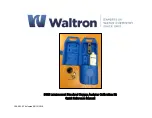
Cat. No. .......................................................... L4 HSL
USB Input Volts .................................................5V DC
USB Input Amps ..........................................0.1 - 2.1 A
Output Volts ...................................................... 4V DC
Output Amps ........................................................ 2.1 A
Volts .................................................................. 4V DC
REDLITHIUM
®
USB Batteries
Operating Temperature
Battery and Charger ..... 4°C to 40°C (40°F to 104°F)
Battery and Tool ............-20°C to 60°C (4°F to 140°F)
Volts
Direct Current
Amps
Do not stare at the operating light source
Read Operator's Manual
WARNING
Maintenance and Storage
Disposing of
MILWAUKEE
®
Li-Ion Battery
Inserting the Battery
Charging the Battery
1.
2.
3.
Green Flashing: Charging, 80-99% charged
Green Solid: 100% Charged
Red/Green Flashing: Damaged or Faulty Battery
Red Solid: Charging, 0-79% charged
SPECIFICATIONS
SYMBOLOGY
BATTERY
Do not expose your battery or cordless tools to water
or rain, or allow them to get wet. This could damage the
tool and battery. Do not use oil or solvents to clean or
lubricate your battery. The plastic casing will become
brittle and crack, causing a risk of injury. Store batteries
at room temperature away from moisture. Do not store
in damp locations where corrosion of terminals may
occur. As with other battery types, permanent capacity
loss can result if the pack is stored for long periods of
time at high temperatures (over 50°C ).
MILWAUKEE
®
Li-Ion batteries maintain their charge during storage
longer than other battery types. After about a year of
storage, charge the battery as normal.
To reduce the risk of injury or
explosion, never burn or incinerate
a battery pack even if it is damaged, dead or
completely discharged. When burned, toxic fumes
and materials are created.
MILWAUKEE
®
Li-Ion batteries are more
environmentally friendly than some other types of
power tool batteries. Always dispose of your battery
according to federal, state and local regulations.
Contact a recycling agency in your area for recycling
locations.Even discharged batteries contain some
energy. Before disposing, use electrical tape to cover
the terminals to prevent the battery from shorting,
which could cause a fire or explosion.
LIGHT
Line up the battery with the compartment and fully
insert the battery.
Unscrew thumbscrew and open door.
Replace door and screw thumbscrew until it is
tight.
1.
2.
3.
Plug your USB cable into a power source such as
an AC wall adaptor, computer or car port. Charge
rates may vary depending on the power source’s
maximum output.
Lift the rubber cover to expose the micro USB port.
Insert the micro USB plug into the micro USB port.
The indicator light will display the charging status:
If the light indicator flashes red and green, check
that the battery is fully seated into the bay.
Remove the battery and reinsert. If the light
continues to flash red and green, the battery may
be extremely hot or cold, or wet. Allow the battery
to cool down, warm up, or dry out and then
reinsert. If the problem persists, contact a
MILWAUKEE
®
service facility.
2
Regulatory Compliance Mark (RCM).
This product meets applicable regulatory
requirements.
WARNING
The light source contained in this
luminaire shall only be replaced by
the manufacturer or his service agent or a similar
qualified person.
IP Ratings............................................................. IP54
Rated Voltage ...................................................4V DC
Rated Power Input..................................................5W
Class III product
Operation
CAUTION
Red Flashing: 0-3% remaining
Red Solid: 3-10% remaining
Yellow Solid: 11-49% remaining
Green Solid: 50-100% remaining
WARNING
To reduce the risk of injury, do not
stare at the operating light source.
Press the power button to cycle through HIGH,
LOW, and OFF. The indicator light will display the
battery life:
To reduce the risk of injury, always
unplug the charger and remove the
battery from the charger before performing any
maintenance. The charger and battery have no
internal serviceable parts. Never disassemble the
battery or charger.
Maintenance and Storage
Store your charger in a cool, dry place.
As a general practice, it is best to unplug battery
chargers and remove batteries when not in use. No
battery damage will occur, however, if the charger and
battery are left plugged in.






















